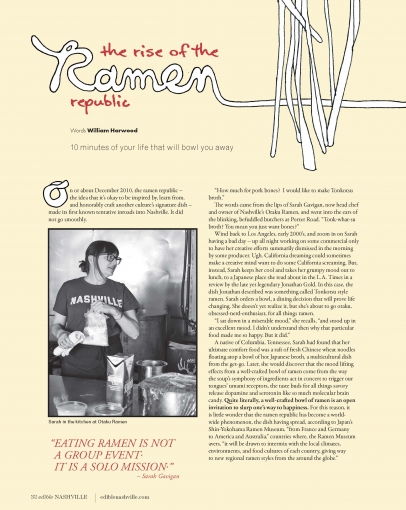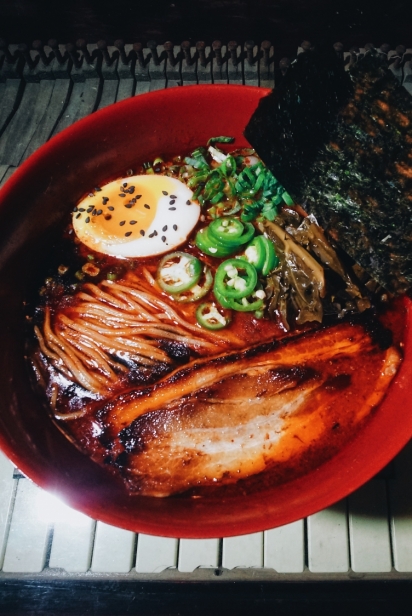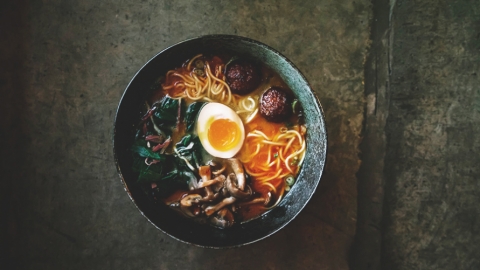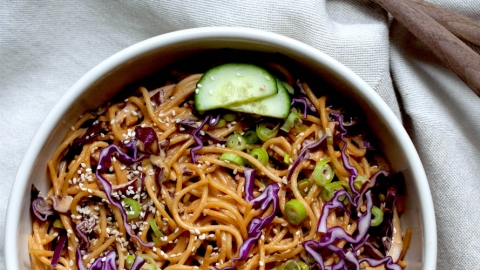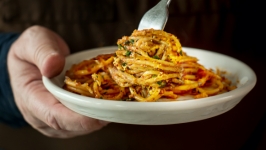The Rise of the Ramen Republic
On or about December 2010, the ramen republic -- the idea that it’s okay to be inspired by, learn from, and honorably craft another culture’s signature dish -- made its first known tentative inroads into Nashville. It did not go smoothly.
“How much for pork bones? I would like to make Tonkotsu broth.”
The words came from the lips of Sarah Gavigan, now head chef and owner of Nashville’s Otaku Ramen, and went into the ears of the blinking, befuddled butchers at Porter Road. “Tonk-what-su broth? You mean you just want bones?”
Wind back to Los Angeles, early 2000’s, and zoom in on Sarah having a bad day -- up all night working on some commercial only to have her creative efforts summarily dismissed in the morning by some producer. California dreaming could sometimes make a creative mind want to do some California screaming. But, instead, Sarah kept her cool and took her grumpy mood out to lunch, to a Japanese place she had read about in the L.A. Times by the late Jonathan Gold. The dish he described: something called Tonkotsu style ramen. Sarah orders a bowl: a dining decision that will prove life changing. Sarah doesn’t yet realize it, but she’s about to go otaku -- obsessed-nerd-enthusiast -- for all things ramen.
“I sat down in a miserable mood,” she recalls, “and stood up in an excellent mood. I didn’t understand then why that particular food made me so happy. But it did.”
A native of Columbia, Tennessee, Sarah had found that her ultimate comfort food was a raft of fresh Chinese wheat noodles floating atop a bowl of hot Japanese broth, a multicultural dish from the get-go. Later, she would discover that the mood lifting effects from a well-crafted bowl of ramen come from the way the soup’s symphony of ingredients act in concert to trigger our tongues’ umami receptors, the taste buds for all things savory release dopamine and serotonin like so much molecular brain candy. Quite literally, a well-crafted bowl of ramen is an open invitation to slurp one’s way to happiness. For this reason, it is little wonder that the ramen republic has become a worldwide phenomenon, the dish having spread, according to Japan’s Shin-Yokohama Ramen Museum, “from France and Germany to America and Australia,” countries where, the Ramen Museum avers, “it will be drawn to intermix with the local climates, environments, and food cultures of each country, giving way to new regional ramen styles from the around the globe.”
Still, while the spread of ramen beyond Japan is indisputable, its exact origins remain as cloudy as, well, a pot of swirling Tonkotsu broth. (Legend has it that this creamy style originated by mistake; a cook somewhere in the south of Japan fell asleep and, overnight, the clear pork broth intended turns instead milky white from the churning bones.) According to the Shin-Yokohama Ramen Museum, ramen’s roots go back to the late 1850’s when Japan was forced at cannon point to open its ports to the outside world, allowing in, among other items, Chinese wheat noodles with a taste and texture quite alien to the palate of rice-centric Japanese. Chinese restaurants began appearing in Japanese port cities where soba noodles fed hungry dock workers and modern ramen developed. However, it wasn’t until after WWII that ramen really took off. Massive amounts of American wheat kept people fed as Japan faced rice shortages while transforming into a capitalist democracy. It was during this period, 1958, that Momofuku Ando famously figured out how to make and package instant ramen noodles and, in the process, feed generations of college students as yet unborn. By the late 1960’s, with the economy now booming, ramen had established itself as Japan’s number one fast-food, providing quick and satisfying meals to busy folks in a rush.
Today, over 25,000 ramen shops in Japan serve up a jaw-dropping array of regional and even local styles, all united by a common ethos summed up in the Japanese concept of kodawari -- the commitment to achieving perfection even when perfection is an unattainable ideal. For example, the concept of kodawari is the reason why a ramen’s broth alone, its dashi, can contain dozens of ingredients and take days to prepare. And still it could be better. That’s kodawari.
Chef Jessica Benefield and husband Trey, owners of Two Ten Jack in East Nashville, certainly have the ethos of kodawari cooking in their kitchen. “Kodawari is artisanal,” Trey says. “For us, every aspect of what we do has its kodawari point. We go in everyday and try to make something better than it was the day before.”
Having known each other since high school, the pair found on a visit to Japan that they loved not just each other, but Japanese cuisine as well. “You can eat for very little money there,” Jessica says. “The style of dining that Trey and I enjoy the most is small-plate sharing and hanging out with friends. Two Ten Jack allows us to share that passion.”
The pair also developed a love for the wide variation of ramen styles, particularly their complex broths and accompanying flavorful tares (sauces). Since April of 2015, when Two Ten Jack first opened, the two constants have been that the broths and tares are always evolving and that, Chef Jess admits, “it always hurts a little bit to serve the hot bowls.”
Chef Rooney and his talented team at Black Dynasty Secret Ramen House also honor the ethos of kodawari. That means a culinary question like “soubise or not soubise?” is a total no-brainer: heck, yes, Black Dynasty’s brothy bowls of vegan ramen -- their mushroom tonkotsu -- demand handcrafted, vegan soubise (white sauce of onion), and at the exact ratio of 1 and ½ quarts to every 6 quarts of homemade veggie stock to every 1 quart homemade vegan tare. It doesn’t matter that the vegan version is by far the hardest to make, taking a full two days to prepare each brothy batch. It also doesn’t matter that the mushroom tonkotsu is consistently outsold by both the miso tonkotsu and the shoyu chintan, the pork and chicken broth bases respectively. What matters to Chef Rooney and his team is that they honor the expert artisanship requisite of a well-crafted bowl of ramen. To help remind the team of this ideal, kodawari is emblazoned in Japanese script atop the stylized samurai on the door of the walk-in freezer.
“It’s a lot of work,” Chef Rooney admits, reflecting on his vegan broth. “The soubise calls for canola and flour for the roux before adding the almond milk and the roasted, caramelized mushrooms, apples, onions, garlic, and ginger. The veggie stock calls for charred mirepoix (a mixture of onions, celery, and carrots), and that’s before we even make our own tare and our own Chinese wheat noodles. We tried to streamline it, but in the end we said, ‘screw it.’ We can’t change it. It’s just too good.”
The setting for Black Dynasty is the cramped yet cranking kitchen of Bar Sovereign in the SoBro district, a funky, bohemian bar that pairs perfectly with Chef Rooney and his team who cultivate their kitchen kodawari like some kind of culinary punk rock band, a parallel that Chef Rooney, a former punk rock musician himself, is quick to acknowledge.
“Honestly, it’s the exact same f---ing thing,” he says. “You take all this time for songwriting. All this time for practice. All this time for learning an instrument, manifesting yourself in this way through your song, only for a song to be worth a few minutes. That’s cooking, man.You take all this time to learn about this food. You take all this time to prep. All for someone to eat it in a few minutes.”
Not that Chef Rooney is complaining. Just the opposite. “The point is that we’re making fast food,” he says. “But we’re making it with care and attention and love and thoughtfulness. And it’s an opportunity for us to learn and grow and share our passion.”
Chef Rooney’s own passion for ramen began while cooking at Tànsuŏ, and then later reading David Chang’s Momofuku and taking the time to read Japanese cookbooks. “And I still don’t know anything,” he laughs. “There is so much to consider. So many different styles. The whole ethos here is that we’re not experts. We don’t read a blog post about something and then try to act like authorities on it. That’s not us at all.”
Chef Sarah Gavigan at Otaku Ramen nearby in The Gulch would no doubt agree. “I am an American using American ingredients,” she says. “We don’t have the depth of product available in Japan.”
Maybe so, but Chef Sarah certainly embodies her own passion for ramen, even down to the way it is eaten.
“Eating ramen is not a group event,” Chef Sarah says. “It is a solo mission. That’s why we built the shop to help people feel that way about it. It is a place you can come by yourself and feel at home. The first thing you do is take in the aroma and then taste the broth but eat the noodles as quickly as possible. From the moment we put them in the bowl, the noodles don’t stop cooking. As the temperature of the broth goes down, the flavor profiles actually change as you approach the bottom of the bowl. It’s a journey. A very special and balanced ten minutes of your life.”
And who knows? Perhaps a journey that could change your life as well. Check out all three outposts of Nashville’s ramen republic and remember its motto: e pluribus umami -- from many, savoriness!


